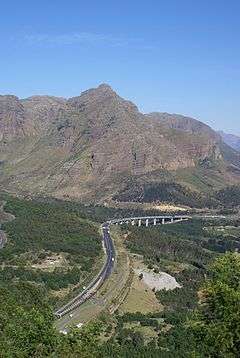Huguenot Tunnel
The Huguenot Tunnel is a toll tunnel near Cape Town, South Africa. It extends the N1 national road through the Du Toitskloof mountains that separate Paarl from Worcester, providing a route that is safer, faster (between 15 and 26 minutes) and shorter (by 11 km) than the old Du Toitskloof Pass travelling over the mountain.
North entrance to the Huguenot Tunnel | |
| Overview | |
|---|---|
| Official name | Abdullah M Omar Tunnel |
| Coordinates | 33.727778°S 19.06667°E |
| Route | |
| Crosses | Du Toitskloof Mountains |
| Operation | |
| Work begun | 1984 |
| Constructed | Hochtief Construction AG Concor Holdings. |
| Opened | 18 March 1988 |
| Technical | |
| Length | 3900 m |
| No. of lanes | 2 |
| Operating speed | 90 km/h |
| Tunnel clearance | 5 m |
History

An idea for a tunnel through the Du Toitskloof Mountains was conceived in the 1930s but was put on hold due to the outbreak of World War Two.[1] The idea developed into a pass over the mountains, the Du Toitskloof pass, using the labour of Italian prisoners of war between 1942 and 1945 and continued with ordinary labour until its completion in 1948.[1] Geological surveys and design started in 1973, and excavation followed in 1984, tunneling from both ends using drilling and blasting.
Construction
There were two phases to the tunneling, the first a pilot tunnel to examine the routes geographical obstacles.[1] The second phase bored a 5 m tunnel through granite rock as well as the construction of portals, drainage and ventilation tunnels.[1] The two drilling heads met with an error of only 3 mm over its entire 3.9 km length. The tunnel was finally opened on 18 March 1988.[1]
The tunnel is maintained by Tolcon, a subsidiary of the Murray & Roberts construction company.[2] The tunnel was constructed by Hochtief Construction AG and Concor Holdings.
Current plans
Currently the tunnel carries one lane of traffic in each direction. Plans are underway to open a second unfinished tunnel, the "northern bore", to carry eastbound traffic. This will allow for two lanes of traffic in each direction, with each tunnel carrying traffic in one direction only.[3][4]
In 2002, traffic peaks occurred during Easter (a record on 26 April 18 200 vehicles) and the December school holidays (12 000 vehicles per day).
Toll
The toll as proclaimed on 1 March 2019[5] was (in South African Rand):
- Light Vehicles: R39,50
- 2-axle heavy vehicles: R110,00
- 3 and 4-axle heavy vehicles: R172,00
- 5 and more-axle heavy vehicles: R278,00
The tunnel has 13 video cameras that feed into an automatic incident detection system, which can sound alarm devices for any of the following conditions:
- Stopped vehicles
- Fast and slow-moving traffic
- Traffic queues
- Wrong-way driving
Sources
- "The Huguenot Tunnel turns 25 this week". The South African National Roads Agency. 19 March 2013. Retrieved 24 September 2017.
- "Tolcon". Murray & Roberts. Archived from the original on 14 May 2010. Retrieved 23 July 2010.
- Powell, Anel (8 September 2008). "Second tunnel for W Cape road link". Cape Times. Independent Newspapers. p. 1. Retrieved 11 August 2009.
- "Transport master plan may cost R750bn". Business Day. 5 May 2010. Retrieved 5 May 2010.
- "Toll Roads". Foresight Publications. Retrieved 8 July 2019.